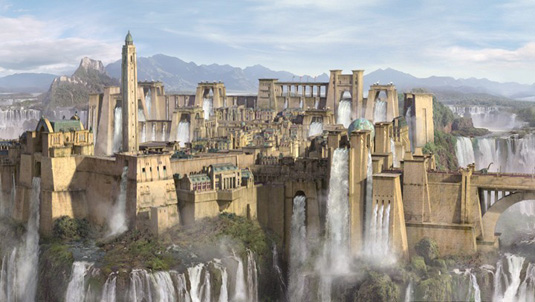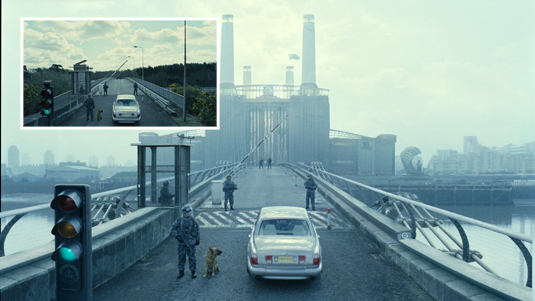Q&A: Frazer Churchill on creating the VFX for The World's End & more!
We talk to Frazer Churchill, the BAFTA-nominated VFX supervisor, and founding member of Double Negative.
Over the last 15 years the visual effects industry has exploded, with London now positioned at the heart of the VFX scene. Despite this being a relatively recent ascendance, there are only a handful of people that have been there from the start, and have experienced the phenomenal growth of this burgeoning industry: Frazer Churchill is one of them.
An industry veteran (not always a term appreciated by those it’s bestowed upon, but in this instance wholly fitting), Churchill began his career at the Moving Picture Company (MPC) where he became one of five artists who set up its new film division in 1994.
Founding Double Negative
Churchill then went on to be a co-founding member of Double Negative in 1998, where the team worked on its first show, Pitch Black. Since then Churchill has been BAFTA-nominated for his work on Children of Men, made the 2011 Oscar bake-off list for his work on Scott Pilgrim, and was most recently VFX Supervisor on the concluding movie in the Cornetto Trilogy, The World’s End.
In this Q&A we talk to Churchill about his career, the foundation of Double Negative, the challenges he’s faced over the years, and how JK Rowling kick-started an amazing period for visual effects in the UK.
Q: How did you get started in VFX?

Like most of us, I got into VFX by accident really. It was about 15 years ago, and there was no industry to speak of. I was working as a graphic designer, part time. I’d done a degree in computer science, with a graphics component, and I wanted to get into computer games. But I didn’t really know how to go about it. A friend of mine had gotten a job at a post-production company called MPC, and I thought maybe I could get into motion graphics or something. He got me a job as a runner, and that was a broad job. You got the tea and delivered the film cans, etc. It was a classic way in, and back then being a runner was the only way in really. They had a small department called 'digital film' whose role was to do tape-to-film transfers, and then we had people come to us with shots from films, and ask if we could do green screen shots. And from there we started getting asked to come on set, and show how various effects scenes should be set up. It kind of developed from there.
Q: What kind of kit were you working with back then? It must have been pretty rudimentary
It was a real mix of analogue and digital. We’d be in the cutting room one minute, and then I’d go upstairs and be writing computer code the next. Then I’d be sending film to the lab, and the next minute I’d be at a computer, compositing a shot. All the software and hardware back then were ludicrously expensive. For a workstation it was coming up to £100,000. In fact, I think our biggest computer at the time was worth around £1m. And probably had around the same computing power as my iPhone these days!
Q: How did the foundation of Double Negative come about?
Polygram Filmed Entertainment had a movie called Pitch Black that they were producing, and they really wanted Peter Chiang as VFX supervisor. Polygram already had a relationship with Peter, who they’d worked with previously on The Borrowers (whilst he was still at MPC). So we broke away to form Double Negative, and work on that project as a new company. We all left thinking: ‘If it’s only one film, it’ll be an adventure!’, and now here we are with 1,300 employees and an office in Singapore.
Daily design news, reviews, how-tos and more, as picked by the editors.

Q: We’re guessing it wasn’t an amicable split?
[LAUGHS] It wasn’t really amicable, no. I think there were a few pointed fingers and raised voices, and mentions of ‘You’ll never work in this town again!’. But you’ve got to expect these things every now and again! [LAUGHS AGAIN]
Q: But the nature of VFX means that you have to work with other companies, right?
Inter-company cooperation is more enforced than by choice, I would say. There might be 1,300 shots, and MPC might get 300 water-based shots, and DNeg will get a few hundred creature shots. And there might be shots that include water and creatures, and we have to work out how we’re going to produce these shots. It’s not like we call each other and say ‘Hey, do you want to help us out?’. It’s just part of a production.
Q: You left DNeg briefly to work on the Dinotopia mini-series. How was that?
I was one of the two VFX supervisors on that show. There was myself, and the late Guy Hudson. He’d worked on the original Alien, making all the splatter and exploding guts! It was really cool working with him. The project wasn’t a huge success, though, but it was a fantastic experience, where I really learned how to be a VFX supervisor. Then, when that project finished, I came back to DNeg and continued my career with Children of Men.

Q: Can you tell us more about Children of Men?
I suppose Children of Men was the first big film I worked on. Children of Men was particularly challenging, as we had to put together scenes that had to come across as single takes, and it wasn’t really something that had been done before.
You’ve got so many variables: you’re shooting something that has to appear as a single shot; something that’s been shot over seven days, which can be affected by a change in weather or performance; and you have to make sure that all those digital joins across multiple shots are seamless. It was difficult shooting it, and convincing people that it was actually going to be possible. But we did it.

Q: Why do you think the UK has become such a hotbed of talent?
It’s a combination. But it was really about Harry Potter. The industry wasn’t really there before; we’d do some VFX work, but it was mostly for British productions, which weren’t particularly high budget. And then JK Rowling insisted that the Harry Potter films were shot in the UK, so Warner Brothers came over, and all the production was done here.
We picked up quite a bit of that work, and we were able to expand our company because of the insistence that the work remain here. And on the back of that we built up a big R&D department, and the company grew to a size where they could handle doing big Hollywood films. So that, and the fact that government offers tax incentives to attract external investment, has meant that the industry has flourished. We’ve got a lot to thank JK Rowling for!
Q: Your last project was as VFX supervisor on The World’s End. How was that?
We had a big practical (non-CG) component to a lot of the visual effects in the film, and that was partly an aesthetic demand of the film, because of the physicality of pulling people's limbs off and smashing their heads in with them. But it was also necessary because of budget. You can say ‘OK, we’re going to have loads of CG exploding heads!’, but that gets expensive very quickly. So we chose to make wax heads, chilled them, filled them with blue stuff, smashed them with iron bars against a green screen, and then composited them into the scene.
So we’re taking a traditional 2D compositing on a lot of the effects in the movie; but because the composting software has become so sophisticated these days, it’s almost like a semi-CG approach.

Q: So there was no ‘Fix it in post!’ mentality?
It’s a real challenge. Everyone has to sign off on an approach like this. The important thing about doing any of this stuff is that the director’s with you. You have to put time aside to shoot these required elements, because everything we’re doing is based on reference. So if you have someone’s broken head, we get the prosthetics guy to make a broken head, walk it onto the set after the main action has finished, we’ll film it under the same lighting conditions, and then we’ll be able to use that element to composite. More time is spent on set, to save you time at the other end.
Q: What does the role of a VFX supervisor actually entail?
Like the production designer in charge of sets, I’m in charge of everything that’s digital in the film. As the head of the visual effects department, I’m in charge of digital elements and the associated production. I’m the director’s eyes and ears in his absence. I work with the team, getting all the work ready to show, and ensuring that we only show it when it’s ready. My job is to understand what the director wants, and make sure that’s what he gets. Not show him things too early or too late, because that’s where you make or break a production.
Q: How closely did you work with Edgar Wright in the planning phase?
It’s all to do with planning. We sit in rooms for weeks talking about shots, and reviewing the storyboard. Edgar’s very meticulous, and there’s nothing that he hasn’t thought about. We sit down with full storyboards for every shot in the film, and then we go through them and devise the techniques, and work out how we’re going to do these shots. The film’s made in meetings. But I think the fact that I’d worked with Edgar before on Scott Pilgrim meant that he trusted me, and he believed me when I said we could do something.

Q: What are you currently working on?
I’m currently working on my own feature film, which has just been picked up by producers, and hopefully I can shoot it next year. That’s something I’m working on as writer/director. It’s a coming of age tale about young breakdancers in South East London; think Quadrophenia meets La Haine. It’s a British drama, but with visual effects sequences to showcase the dancing from an experiential first-person perspective.
Delivered in conjunction with ZED!
This content was produced in collaboration with HP & Intel as part of ZED - a Pop-Up Studio for the Creative Community held in Soho, London. For more information about ZED and any future events see here.

The Creative Bloq team is made up of a group of art and design enthusiasts, and has changed and evolved since Creative Bloq began back in 2012. The current website team consists of eight full-time members of staff: Editor Georgia Coggan, Deputy Editor Rosie Hilder, Ecommerce Editor Beren Neale, Senior News Editor Daniel Piper, Editor, Digital Art and 3D Ian Dean, Tech Reviews Editor Erlingur Einarsson, Ecommerce Writer Beth Nicholls and Staff Writer Natalie Fear, as well as a roster of freelancers from around the world. The ImagineFX magazine team also pitch in, ensuring that content from leading digital art publication ImagineFX is represented on Creative Bloq.
